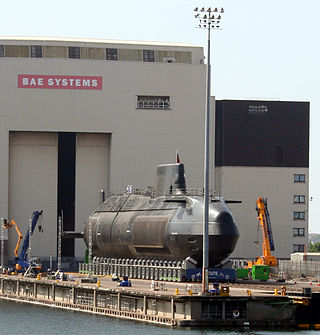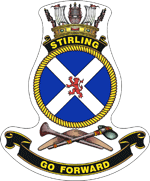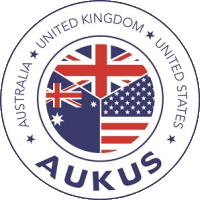| Agency overview | |
|---|---|
| Formed | 1 July 2023 |
| Jurisdiction | Commonwealth of Australia |
| Headquarters | Canberra, Australian Capital Territory, Australia |
| Employees | 350 (1 July 2023) [1] |
| Minister responsible | |
| Agency executive |
|
| Parent agency | Department of Defence |
| Website | www |
The Australian Submarine Agency (ASA), formerly the Nuclear-Powered Submarine Task Force (NPSTF) is the federal statutory agency of the Australian Government responsible for the management and oversight of Australia's nuclear-powered submarine program. The ASA was established as a non-corporate Commonwealth entity under the Department of Defence consisting of defence personnel and Australian public servants. Personnel will be based across Australia as well as in the United Kingdom and the United States, numbering 350 increasing to 680 within the following year. [1]
The role of the ASA is to support Australia's acquisition of nuclear-powered submarines. The acquisition, through the AUKUS partnership, will include three Virginia-class and five SSN-AUKUS submarines. USS Delaware (SSN-791) and USS New Jersey (SSN-796) are likely to be the two existing United States Navy fleet units that will transferred to the Royal Australian Navy, with the third vessel being a new build. [2]
The ASA will be the lead agency for nuclear vessel construction, with the Osborne Naval Shipyard designated as the preferred location for the construction of nuclear submarines in Australia. [3] Five Australian SSN-AUKUS submarines will be built in South Australia as part of the arrangement with an undetermined amount of the same design to be built by BAE Systems Submarines for the Royal Navy. [4]
As part of the transition from diesel-electric to nuclear-powered submarines, the Royal Australian Navy will be using one Royal Navy and four United States Navy submarines stationed at HMAS Stirling on a rotational basis under the name Submarine Rotational Force – West (SRF-West). [5]
| Name | Post- nominals | Term began | Term ended |
|---|---|---|---|
| Vice Admiral Jonathan Mead | AO | 1 July 2023 | Incumbent |

The Royal Australian Navy (RAN) is the naval force of the Australian Defence Force (ADF). The professional head of the RAN is Chief of Navy (CN) Vice Admiral Mark Hammond AM, RAN. CN is also jointly responsible to the Minister of Defence (MINDEF) and the Chief of Defence Force (CDF). The Department of Defence as part of the Australian Public Service administers the ADF.
The Ship-Submarine Recycling Program (SRP) is the process that the United States Navy uses to dispose of decommissioned nuclear vessels. SRP takes place only at the Puget Sound Naval Shipyard (PSNS) in Bremerton, Washington, but the preparations can begin elsewhere.

The Virginia class, or the SSN-774 class, is the latest class of nuclear-powered cruise missile fast-attack submarines in service with the United States Navy. Designed by General Dynamics Electric Boat (EB) and Huntington Ingalls Industries, the Virginia class incorporates the latest in stealth, intelligence gathering, and weapons systems.

The Astute class is the latest class of nuclear-powered fleet submarines (SSNs) in service with the Royal Navy. The boats are being constructed by BAE Systems Submarines at Barrow-in-Furness. Seven boats will be constructed: the first of class, Astute, was launched by Camilla, Duchess of Cornwall, in 2007, commissioned in 2010, and declared fully operational in May 2014. The Astute class is the replacement for the Trafalgar-class fleet submarines in Royal Navy service.

An attack submarine or hunter-killer submarine is a submarine specifically designed for the purpose of attacking and sinking other submarines, surface combatants and merchant vessels. In the Soviet and Russian navies they were and are called "multi-purpose submarines". They are also used to protect friendly surface combatants and missile submarines. Some attack subs are also armed with cruise missiles, increasing the scope of their potential missions to include land targets.

USS Nautilus (SSN-571) was the world's first operational nuclear-powered submarine and the first submarine to complete a submerged transit of the North Pole on 3 August 1958. Her initial commanding officer was Eugene "Dennis" Wilkinson, a widely respected naval officer who set the stage for many of the protocols of today's Nuclear Navy of the US, and who had a storied career during military service and afterwards.

A nuclear submarine is a submarine powered by a nuclear reactor, but not necessarily nuclear-armed. Nuclear submarines have considerable performance advantages over "conventional" submarines. Nuclear propulsion, being completely independent of air, frees the submarine from the need to surface frequently, as is necessary for conventional submarines. The large amount of power generated by a nuclear reactor allows nuclear submarines to operate at high speed for long periods, and the long interval between refuelings grants a range virtually unlimited, making the only limits on voyage times being imposed by such factors as the need to restock food or other consumables.

Future planning of the Royal Navy's capabilities is set through periodic Defence Reviews carried out by the British Government. The Royal Navy's role in the 2020s, and beyond, is outlined in the 2021 defence white paper, which was published on 22 March 2021. The white paper is one component of the Integrated Review of Security, Defence, Development and Foreign Policy, titled as Global Britain in a Competitive Age which was published on 16 March 2021.

USS New Mexico (SSN-779) is a Virginia-class nuclear powered fast-attack submarine of the United States Navy. She is the second U.S. warship named for the 47th state, after the early twentieth century super-dreadnought,USS New Mexico (BB-40).
The Barracuda class is a nuclear attack submarine, designed by the French shipbuilder Naval Group for the French Navy. It is intended to replace the Rubis-class submarines. Construction began in 2007 and the first unit was commissioned on 6 November 2020. The lead boat of the class, Suffren, entered service on 3 June 2022.

An SSN is a nuclear-powered general-purpose attack submarine. SSN is the US Navy hull classification symbol for such vessels; the SS denotes a submarine and the N denotes nuclear power. The designation SSN is used for interoperability throughout NATO under STANAG 1166, though navies use other terms.

HMAS Stirling is a Royal Australian Navy (RAN) base that is part of Fleet Base West situated on the west coast of Australia, on the Indian Ocean. The base is located on Garden Island in the state of Western Australia, near the city of Perth. Garden Island also has its own military airport on the island. HMAS Stirling is currently under the command of Captain Gary Lawton.
The Royal Australian Navy, although a significant force in the Asia-Pacific region, is nonetheless classed as a medium-sized navy. Its fleet is based around two main types of surface combatant, with limited global deployment and air power capability. However, in 2009, a white paper, Defending Australia in the Asia Pacific Century: Force 2030, was produced by the Australian government which set out a programme of defence spending that will see significant improvements to the RAN's fleet and capabilities.

The Australia, New Zealand, United States Security Treaty is a 1951 non-binding collective security agreement initially formed as a trilateral agreement between Australia, New Zealand, and the United States; and from 1986 an agreement between New Zealand and Australia, and separately, Australia and the United States, to co-operate on military matters in the Pacific Ocean region, although today the treaty is taken to relate to conflicts worldwide. It provides that an armed attack on any of the three parties would be dangerous to the others, and that each should act to meet the common threat. It set up a committee of foreign ministers that can meet for consultation.

The Royal Navy Submarine Service is one of the five fighting arms of the Royal Navy. It is sometimes known as the Silent Service, as submarines are generally required to operate undetected.
United States ship naming conventions for the U.S. Navy were established by congressional action at least as early as 1862. Title 13, section 1531, of the U.S. Code, enacted in that year, reads, in part,
The vessels of the Navy shall be named by the Secretary of the Navy under direction of the President according to the following rule: Sailing-vessels of the first class shall be named after the States of the Union, those of the second class after the rivers, those of the third class after the principal cities and towns and those of the fourth class as the President may direct.

The Attack-class submarine was a planned class of French-designed submarines for the Royal Australian Navy (RAN), expected to enter service in the early 2030s with construction extending until 2050. The project, which would have replaced the Collins-class submarines, began in 2007 as the Future Submarine program. In 2020 it was estimated to cost A$90 billion and would have been the largest and most complex defence acquisition project in Australian history.

AUKUS, also styled as Aukus, is an acronym for the trilateral security pact between Australia, the United Kingdom, and the United States, announced on 15 September 2021 for the Indo-Pacific region. Under the pact, the US and the UK will assist Australia in acquiring nuclear-powered submarines. The pact also includes cooperation on advanced cyber mechanisms, artificial intelligence and autonomy, quantum technologies, undersea capabilities, hypersonic and counter-hypersonic, electronic warfare, innovation and information sharing. The pact will focus on military capability, separating it from the Five Eyes intelligence-sharing alliance that also includes New Zealand and Canada.

The SSN-AUKUS, also known as the SSN-A, is a planned class of nuclear-powered fleet submarine (SSN) intended to enter service with the United Kingdom's Royal Navy in the late 2030s and Royal Australian Navy in the 2040s. The class will replace the UK's Astute class and Australia's Collins class submarines.